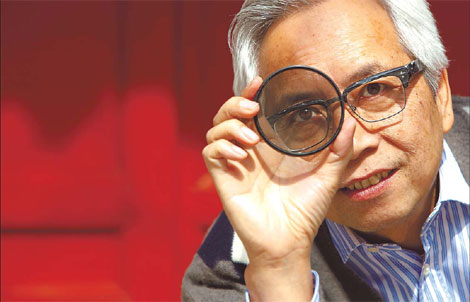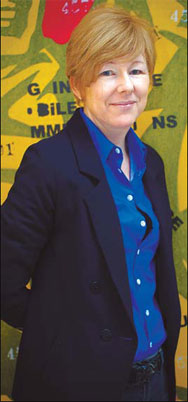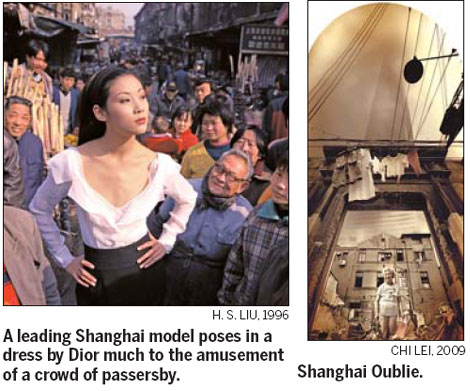Putting Shanghai in focus
|
 Liu Heung Shing, or H.S., poses with a lens filter at his courtyard home outside the Forbidden City. Jonah M Kessel / China Daily |
Capturing the essence of this mainland city is an immense challenge that has been met by Pulitzer prize winning photographer H.S., Andrew Moody reports
Few people could get away with casually dropping into the conversation that Deng Xiaoping was a "very charming guy", as though the former Chinese leader was someone who used to regularly pop round for tea. Pulitzer prize winning photographer Liu Heung Shing can, perhaps, be forgiven for the odd name drop since he has focused his lens on many of the 20th Century's most iconic figures.
H.S., as he is known, makes the reference to Mao Zedong's successor while reminiscing at the kitchen table of his hutong courtyard house on the edge of the Forbidden City.
"I photographed him (Deng) many times. He was extremely powerful and felt very comfortable about himself," he says.
"When he greeted visitors like President George Bush senior, he wouldn't worry about smoking or having a spittoon in the corner. He was a man who was completely in charge."
|
 Chinese contemporary art expert Karen Smith has produced the photo book with Liu. The book is a visual representation of the history of Shanghai from the end of the Opium War to this year's World Expo. Jonah M Kessel / China Daily |
Some of H.S.'s photographs are in a new book Shanghai: A History in Photographs, 1842-Today, which he has produced with his partner, Karen Smith, an internationally renowned expert on Chinese contemporary art.
The Penguin publication, which charts in images the history of the city from the end of the first Opium War to the present day, is timed to coincide with the Shanghai Expo.
Apart from works by H.S., the book contains images from the Jardine Matheson Archive, private collections, photographic giants such as Henri Cartier-Bresson, and newly commissioned works from the latest photographers who have taken on the challenge of photographing the city.
Images from the book will be shown on a display screen within the Shanghai Corporate Pavilion at the Expo.
Smith, who is originally from Britain, said some photographers turned down the chance to contribute to the book because it is difficult to get behind the surface of the skyscraper skyline image.
"Photographing Shanghai is a huge challenge. A number of photographers find it very difficult Getting beneath the surface of Shanghai is very difficult," she says.
The early sections of the book relating to when Shanghai was divided into foreign controlled quarters was an era in which Chinese did not have cameras, so all the pictures were taken by Westerners.
Smith said there was a tendency in this era for foreigners to see Chinese people as exhibits.
"In the first chapters we try and avoid photographs that make the subjects look like specimens under the microscope," she says.
H.S., who has had the privilege of free access to municipal archives, said he didn't want to dwell in the book on the differences between foreign and Chinese photographers' perceptions of Shanghai.
"The story of this book is not about how Western or Chinese photographers photographed China but about photography as a visual tool," he says.
Although he now lives in Beijing, H.S. has the perspective of a partial outsider, having been born in British ruled Hong Kong, in 1951.The son of a journalist, he went on to study at New York University, where he did a course with Life magazine photographer Gjon Mili, a major influence on his work.
"He taught me that when you put shutter speed, aperture and the speed of the film together, those three elements become a tool and a medium that can tell a different story than a painter," he says.
The brief introduction to photography led to an internship at Life magazine and set him on the road to a glittering career as a photojournalist.
He became a Time magazine photographer in Beijing when Western news organizations were allowed in to China in 1978 as Sino-American relations normalized.
He won his Pulitzer prize in 1992 after working as picture editor for the news agency Associated Press during the collapse of the Soviet Union.
"It was a scary time but not as scary as covering the Afghanistan war after the Soviet troops pulled out and the country plunged into civil war."
One of the more intriguing H.S. photographs in the book is of a Shanghai model in a Dior dress being photographed in the cramped conditions of her neighborhood, creating a contrast with the chic image she presented to the rest of the world.
"It took me a week to persuade her to take me back to where she lives. She was very tall and her head touched the ceiling in her house," H.S. says.
|
 |
Smith added: "It is something that is said about Shanghai people, that they live in incredibly cramped conditions but everyone goes out in a finely pressed suit."
H.S. and Smith met in 1997 at the Courtyard Gallery in Beijing, where Smith was director.
An artist in her own right having studied painting and printmaking at Wimbledon School of Art, Smith was already establishing herself as an authority on contemporary Chinese art after arriving in the country in 1992.
Smith is a respected author and has also organized major exhibitions on Chinese art such as one at The Tate Gallery in Liverpool three years ago.
She believes that some of the old clichs about China are disappearing.


















